Several species of insects bore into New Hampshire apple trees, including roundheaded apple tree borer, flatheaded apple-tree borer, dogwood borer (and the uncommon look-alike, apple bark borer), leopard moth, and broad-necked root borer. Some people also consider pith moth and European corn borer to be in this category, so this fact sheet includes them as well. At the end you’ll find a key to the borers, which helps you identify them based on the damage and general characteristics of the insects.
Roundheaded apple-tree borer (RHATB) Saperda candida Fab.
This is the most serious borer in New Hampshire apple trees. The adults are striking brown-and-white-striped beetles, almost an inch long. The females lay eggs from early June through August in bark crevices in the lower two feet of the trunk. Upon hatching, the larvae bore into the tree and begin feeding on the outer bark, gradually getting deeper and boring into the wood. Young larvae sometimes bore into wood below the ground surface, but older larvae feed above ground. It takes two (sometimes three) years to complete the life cycle.
Larvae are yellowish-white with brown heads. A row of dark brown dots (holes for the respiratory system) are visible down each side. Fully grown larvae are over an inch long. As they bore, they push coils of fibrous frass out of the tunnel. Some frass may be visible on the outside of the trunk. The tunnels of RHATB are round in cross-section.
In spring of their second year, the larvae pupate in the tunnel and emerge as adults in summer. Emerging adults leave a round exit hole in the trunk about the diameter of a pencil. The adults spend a lot of time in apple foliage, and that may be one reason that we see relatively few RHATB problems in trees of bearing age on conventional farms. Conventional growers usually use insecticides during summer to control apple maggot, leafminers, and other pests. Backyard trees, trees of pre-bearing age, and organically grown trees have the most problems, and they are often serious, killing the tree.
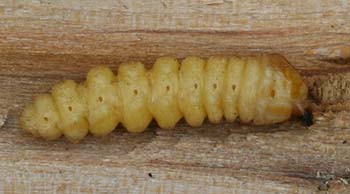
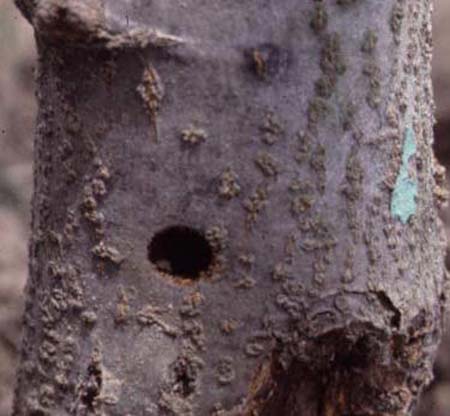
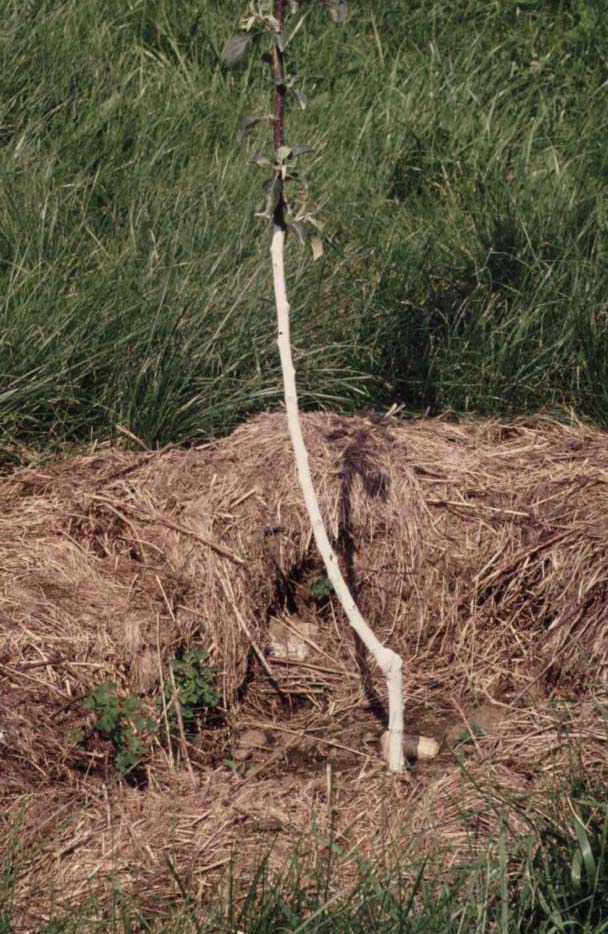
Controls for RHATB
1. If possible, remove nearby (within 100 to 200 yards) unmanaged alternate hosts, before planting your young trees. Apple, crab apple, hawthorn, shadbush and mountain ash are all major hosts of this species. They can be sources of the beetles.
2. Paint the lower two feet of the trunks of your young trees. Use white latex paint, mixed 50/50 with water. This reduces attack, but isn’t 100% successful. It offers the additional advantage of reducing the risk of “southwest injury” during the winter.
3. Keep trunks exposed, free of vegetation, weeds or trash shading the trunks. Most injury seems to occur where tall grass or other debris helped hide the adults when they laid eggs. The photo below shows options 2 & 3 both used, very effectively.
4. This may not be very practical, but you could completely surround the lower 2 to 3 feet of trunk with insect screening, snugly sealed so the beetles can’t get in. You’d want this protection to be there for all of June, July and August. Then you’d have to remove it to avoid injuring the trunk or affecting hardening off in the fall/winter. This option presents lots of problems, including injury where you fasten the screening. 5. You can use pesticides registered as trunk sprays, but you’d have to apply it before the borers hatched and got in. There are special rules and precautions to follow, which vary product to product. The only insecticides available for backyard growers don’t last very long and don’t penetrate the bark. Commercial growers have more choices, covered in the current New England Tree Fruit Management Guide.
6. You could try mechanical “worming.” That entails searching the trunks carefully, and when you find a spot with strings of fine frass being pushed out of the wood, you’ve got an active borer. Insert a flexible wire into the tunnel, and try to impale the larva. This takes a lot of work, but sometimes it can be effective. More experience may translate into a higher success rate. Growers who get this to work have to do it two or three times a year—April and early September being the most common. There’s no use trying to poke a wire into a round exit hole. That borer has left.
Flatheaded apple-tree borer (FATB) Chrysobothris femorata (Olivier)
This insect is also a beetle, in the family Buprestidae. It attacks most species of deciduous fruit trees, plus many forest and shade trees and shrubs. In apple orchards, it occasionally becomes a problem, primarily on trees of pre-bearing age, or in organic orchards.
The beetle overwinters as a larva under the bark or in the wood. The head end of the larva is very broad and flattened (the broad part is actually the thorax immediately behind the head), and this gives the family name “flat-headed wood borers.” The remainder of the body is cylindrical. The larva is yellowish-white and lacks legs. Fully grown larvae are slightly longer than an inch. Tunnels are oval in cross section and the insects pupate there in spring and emerge as adults in summer. They leave oval emergence holes.
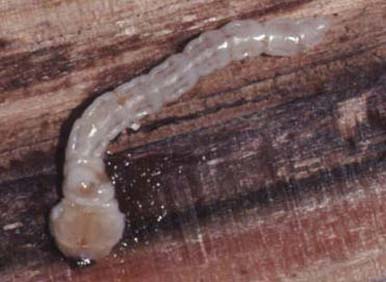
In New Hampshire adults are most common in June and July. They are olive to brown, ½ inch long, with a metallic luster. When they take flight, the brilliant metallic blue-green of the upper abdomen becomes visible. It is usually hidden by the wing covers. (In the photo below, I removed the left wing cover to make the abdomen visible.)

Adults are strongly attracted to freshly cut live deciduous wood and brush, especially from logging or firewood operations. They especially like the sunny sides of trees. The females lay eggs in bark crevices, especially on the sunny side. Weakened, stressed, or strongly leaning trees are most frequently attacked.
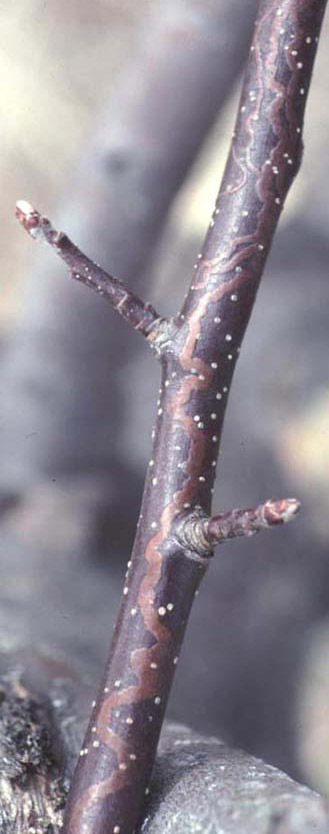
The young larvae create winding tunnels just under the bark on the sunny sides of branches. As they get older, they bore more deeply into the wood. Tunnels are tightly packed with fine “sawdust” or (in wood) fibrous material. A single larva can sometimes girdle a young tree. The life cycle takes one year.
In conventionally sprayed orchards, insecticides directed at other pests control this borer, except in trees of pre-bearing age, which usually are sprayed less frequently. In higher-risk orchards (trees of pre-bearing age, or organically managed), take care not to pile firewood nearby; hundreds of adult borers may emerge from it the summer after it was cut down. Properly brace trees that require support, so they’ll grow straight.
Dogwood borer (and apple-bark borer) Synanthedon scitula (Harris) & S. pyri (Harris)
Unlike the previous species, dogwood borer is a caterpillar. The adult is a small, day-flying moth that looks a bit like a wasp. This insect increased in importance when growers shifted to semi-dwarf and dwarf rootstocks, especially those that produce lots of burr knots towards the base of the tree. A nearly identical species, apple-bark borer, is occasionally found in New Hampshire apple trees as well.

Both species overwinter as larvae, boring into the bark, cambium, and outermost layer of sapwood. Fully grown larvae are ½ inch or longer, whitish caterpillars (tiny legs are visible), often with an orange tinge. A few tiny pellets of dark brownish-orange frass are sometimes pushed out of tunnels, evident to someone who looks closely at the burr-knot area. The insects pupate in their galleries in early summer. A few adults appear in June, but most fly in July and August.
The female moths lay their eggs in bark crevices, especially around healed wounds and burr knots. In dwarf trees they are found predominantly near the base of the trunk. In large trees, they are often near large healed pruning cuts and limb injuries. The caterpillars hatch and the cycle continues. There is just one generation per year.

We haven’t determined how many borers it takes to make treatment worthwhile, but observations suggest that heavy infestation reduces tree vigor and productivity. There are trunk sprays available for commercial growers, but backyard growers have access to fewer products. In commercial orchards, early July is the most effective application time.
Prevention: Rootstocks vary in their production of burr knots. Avoiding rootstocks that have a high tendency to produce burr knots—M26, M9 (the Nic29 strain in particular), and the newer rootstock, SJP84- 5180—can help prevent problems.
Avoiding shading and high humidity at the trunk reduces the tendency to produce burr knots, so keep the area around the lower trunk weed-free and open to sunlight, and don’t use opaque wrap-around mouseguards. Plant your trees with the graft union not more than one to two inches above ground.
Applying white latex paint mixed with water (described under RHATB) can also deter some attacks. Synanthedon scitula and S. pyri are so similar, there may be some confusion in the reports on their biology, but hawthorn, mountain-ash and shadbush are also listed as hosts. If many of these (unmanaged) host trees are near your orchard, they might be a significant source of infestation. Eliminating them may help reduce attack, but is less important than the points listed above.
Leopard moth Zeuzera pyrina (L.)
Leopard moth is occasionally found boring in young apple trees. The name comes from the appearance of the adults: 3/4 inch long white moths with many black spots. In New Hampshire, adults are most common from early July through mid-August. Females lay clusters of eggs in bark crevices. When the tiny caterpillars hatch, they crawl a ways before boring into the tree. In apples, we often see borer injury on the trunk of young trees that have suffered mechanical injury of some kind. Growers often locate a borer from the large, coarse pellets of frass that it has pushed out of its tunnel. A fully grown larva can be up to two inches long. The caterpillar is cream colored, with small black spots. The life cycle requires two years, sometimes three.
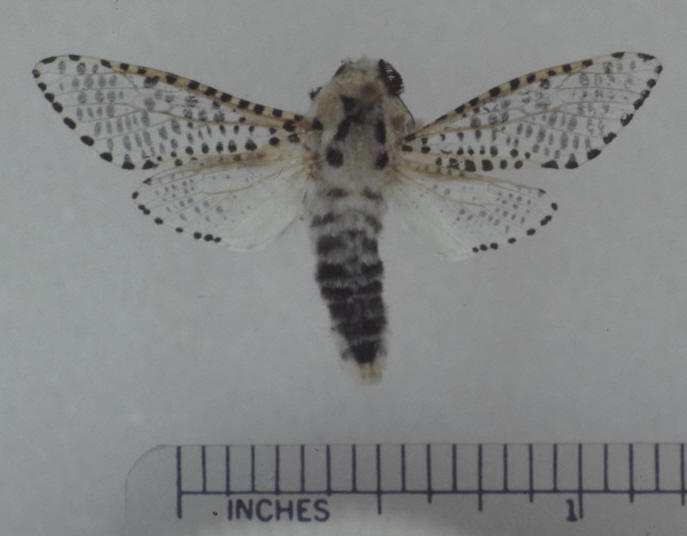
Tunnels are usually relatively straight and large enough that the borer can be killed by probing the opening with a flexible wire. We see this insect most commonly in trees of pre-bearing age and in organic orchards. Since many orchards here are surrounded by woodland, orchard edges are more likely spots for infestation than the interior of a block. This (European) species attacks more than 125 species of hardwood trees. Woodpeckers are major predators of the caterpillars. Avoiding mechanical injury to young trees may reduce the likelihood of attack, but otherwise we can’t do much to prevent attack. Luckily, this one is uncommon, and of minor importance in New Hampshire.
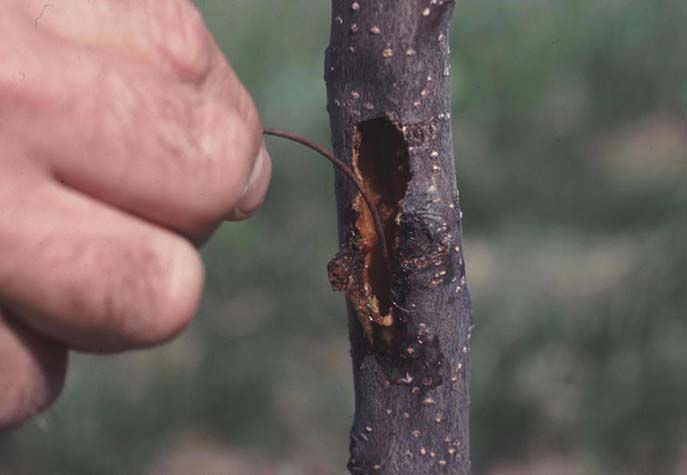
Broad-necked root borer Prionus laticollis (Drury)
This very large beetle is common in New Hampshire and was recently (2009) documented attacking apple trees here. True to its name, it doesn’t attack above ground. It feeds on the roots of many common trees and shrubs, including species of Prunus, Malus, Acer, Quercus and others.

This borer overwinters on or in the roots as a partially grown, whitish cylindrical grub. It can require up to four years to mature. In June, fully mature grubs pupate in the soil adjacent to where they fed. Pupae are 1 to 1 ½ inches long, soft and white. Adults appear in July and August. The females are too large to fly, but the males (smaller) are sometimes attracted to lights. Females lay eggs on roots or in soil adjacent to roots.
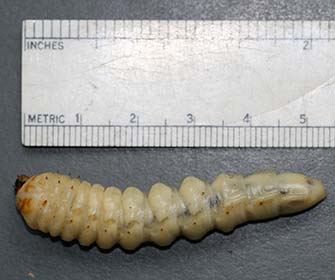
Damage to the root system can be severe. Heavily attacked young apple trees have smaller than usual leaves, little or no shoot growth, off-color (orangish) bark, and poor anchorage. Roots show severe chewing injury; small ones are severed, and large ones are chewed down to a skinny core. The injury might be confused with chewing by voles. Vole injury shows a series of parallel tooth marks, while roots damaged by the borer show a series of smaller, slightly curved marks.
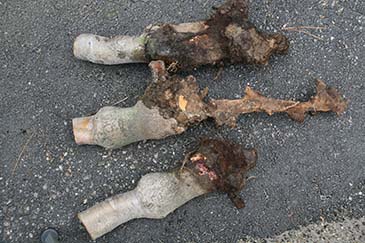
The tile-horned prionis, P. imbricatus might also attack apple trees. It occurs here, but we haven’t found it attacking apple.
We don’t yet know how to prevent attack by root borers. The damage is too new and limited in location. Perhaps soil type and rootstock might affect attack. We have found two other reports of injury to apple trees; one in Connecticut, the other on Long Island, New York.
Pith moth Blastodacna atra (Haworth)
Pith moth is a European species, first found in the U.S. in Connecticut and New Hampshire in 1989. It is most serious on trees of pre-bearing age and/or in organic orchards, but overall it is of minor importance.
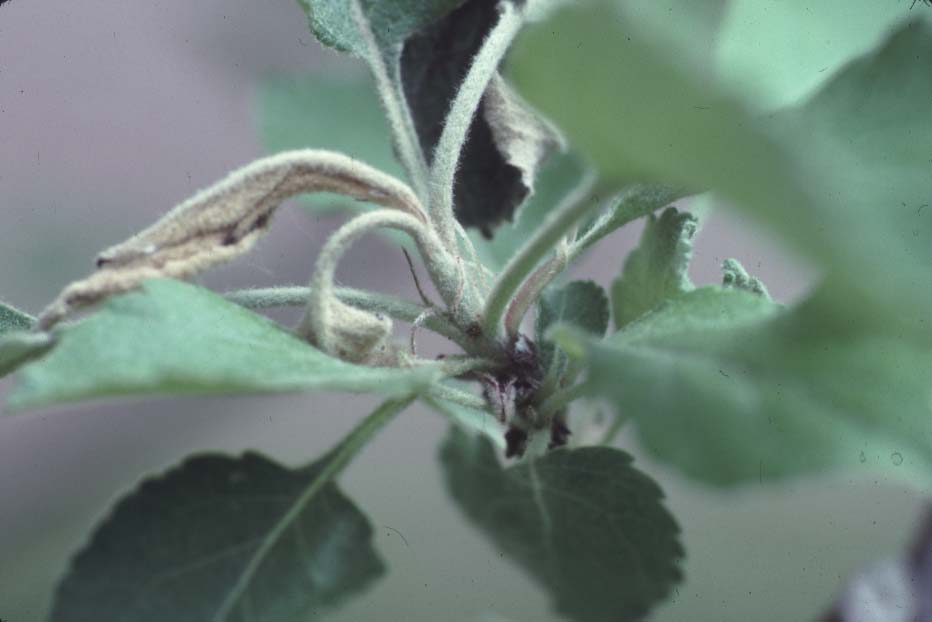
Pith moth overwinters as a partially grown larva, in a tiny excavation it made under the bark. It resumes activity in spring. In May the larva often leaves its overwintering site to bore into a tender shoot or stem of a flower cluster. When fully grown, the caterpillar is up to ½ inch long, pinkish in color, and covered with very fine, short, dense hairs, giving it a velvety appearance.
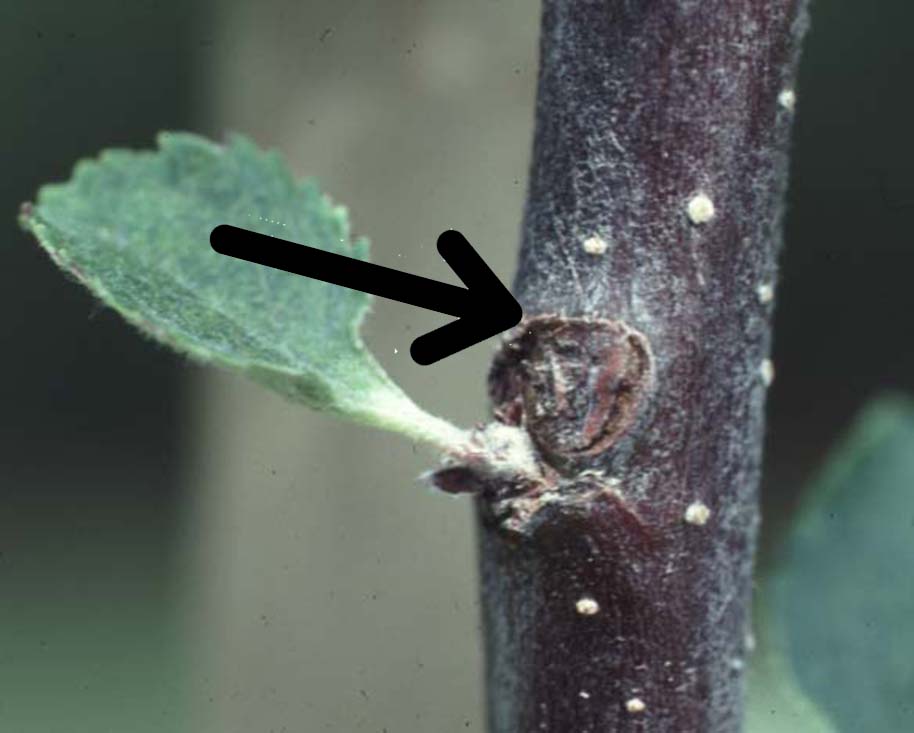
In June the caterpillars pupate in the shoot, and the 1/5-inch, yellow-brown pupae are sometimes found by growers investigating twig or shoot injury. They emerge as 3/16-inch moths in July. Moths are dark, with some rusty and whitish markings. They mate, and females lay eggs singly on apple shoots and twigs, often right next to a bud or in a bark crevice. The tiny caterpillars hatch in August and bore into the twigs immediately, before the twigs toughen up too much. There is just one generation per year. Insecticides directed against other pests [especially around pink stage or in August] usually keep this insect under control.
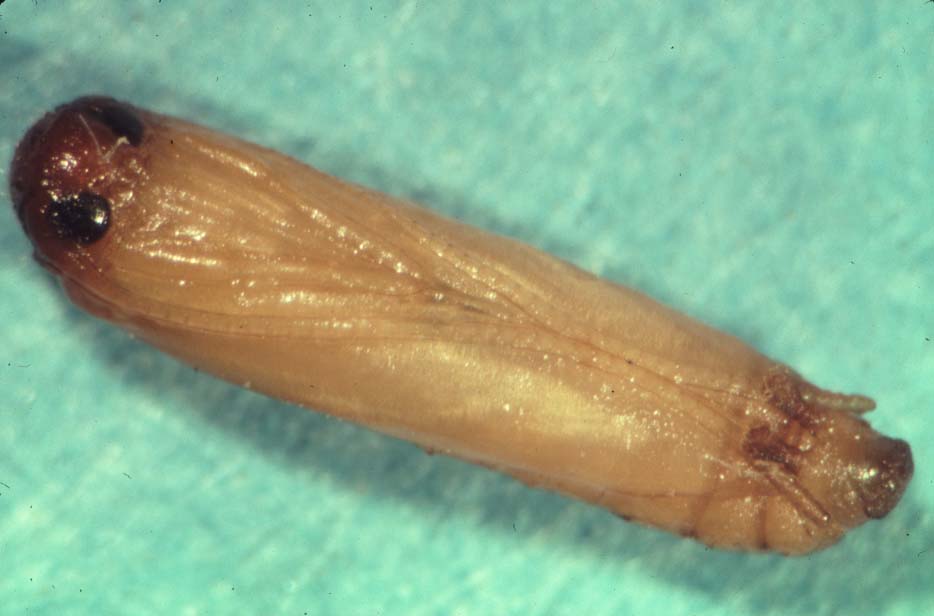
European corn borer Ostrinia nubilalis (Hubner)
European corn borer has two generations per year in New Hampshire. It occasionally bores into the tender green shoots of young trees, most commonly when they are densely surrounded by tall annual weeds such as lambsquarters or pigweed. This usually occurs in July or August, but might occur a week or two earlier or later. The larva is cream-colored, with faint dots, and a dark brown head. To prevent injury from this pest, control weeds near young trees; don’t let them get too tall and close.
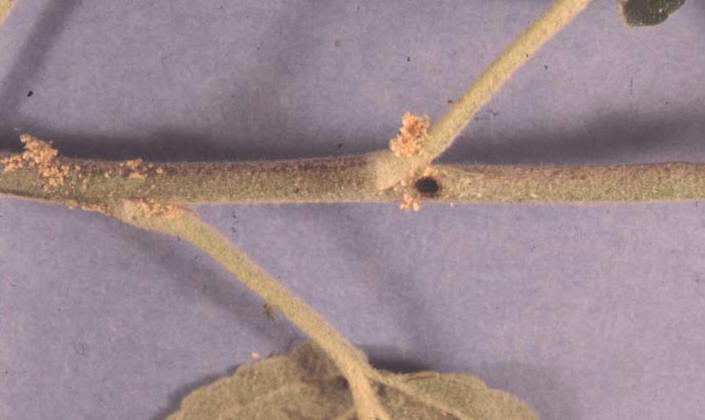
Key to Borers in New Hampshire Apple Trees
This is a dichotomous key, in which the characteristics of the injury and/or characteristics of the specimen will tell what species of borer you have. Start with couplet 1, and see which of the two choices fits your specimen. Follow to the couplet it says until you arrive at an answer.
1 A. Boring in or just under the bark ----- go to couplet 2
1 B. Primarily boring in wood, roots, or in current year’s succulent shoots ----- go to couplet 3
2 A. Primarily found around burr knots or callus tissue on the lower trunk or major limbs. Small caterpillars up to ¾ inch long, sometimes with orange tinge. Caterpillars have visible legs. Apple bark borer or dogwood borer (very similar species).
2 B. winding, raised trails in the bark, visible without digging into bark, found primarily on sunny side of 1-6 year old wood. Larvae are legless. Flatheaded apple-tree borer.
3 A. Tunneling in small twigs or current year’s non-woody shoots ----- go to 7
3 B. Not as above, tunneling through woody growth ----- go to 4
4 A. Medium to large (1/2 inch or longer) caterpillar, with legs visible, boring down central leader, branch or trunk. Light body with small dark spots. Leopard moth.
4 B. Not as above; no visible legs, no dark spots ----- 5
5 A. Whitish grubs with cylindrical body, usually boring at or near the base of the tree, leaving tunnels that are round in cross-section. Roundheaded apple-tree borer.
5 B. not as above ----- 6
6 A. Boring in roots, never above ground. Whitish legless larvae up to 2 inches long. Body is roughly cylindrical in cross section. Broad-necked root borer.
6 B. Boring in wood above ground. Whitish grubs with flattened, broad body segments at the head end, and rest of the body cylindrical. Tunnels broadly oval in cross-section. Flatheaded apple tree borer.
7 A. Boring in current season’s green shoots, summer. Light tan or cream colored caterpillar, with dark brown head. European corn borer.
7 B. Boring in twigs, or (spring) in tender shoots. Very small, velvety pinkish caterpillar. Pith moth.
Photo credits: All photos are by Dr. Alan Eaton, except the adult of dogwood borer, which was taken by James Solomon, USDA Forest Service, and accessed through bugwood.org .
Download the Resource for the complete fact sheet and a printable version.

